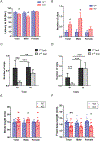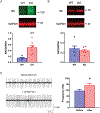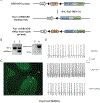Hyperactivity of Purkinje cell and motor deficits in C9orf72 knockout mice
- PMID: 35843530
- PMCID: PMC10369482
- DOI: 10.1016/j.mcn.2022.103756
Hyperactivity of Purkinje cell and motor deficits in C9orf72 knockout mice
Abstract
A hexanucleotide (GGGGCC) repeat expansion in the first intron of the C9ORF72 gene is the most frequently reported genetic cause of amyotrophic lateral sclerosis (ALS) and frontotemporal dementia (FTD). The cerebellum has not traditionally been thought to be involved in the pathogenesis of C9ORF72-associated ALS/FTD, but recent evidence suggested a potential role. C9ORF72 is highly expressed in the cerebellum. Decreased C9ORF72 transcript and protein levels were detected in the postmortem cerebellum, suggesting a loss-of-function effect of C9ORF72 mutation. This study investigated the role of loss of C9ORF72 function using a C9orf72 knockout mouse line. C9orf72 deficiency led to motor impairment in rotarod, beam-walking, paw-print, open-field, and grip-strength tests. Purkinje cells are the sole output neurons in the cerebellum, and we next determined their involvement in the motor phenotypes. We found hyperactivity of Purkinje cells in the C9orf72 knockout mouse accompanied by a significant increase of the large-conductance calcium-activated potassium channel (BK) protein in the cerebellum. The link between BK and Purkinje cell firing was demonstrated by the acute application of the BK activator that increased the firing frequency of the Purkinje cells ex vivo. In vivo chemogenetic activation of Purkinje cells in wild-type mice led to similar motor deficits in rotarod and beam-walking tests. Our results highlight that C9ORF72 loss alters the activity of the Purkinje cell and potentially the pathogenesis of the disease. Manipulating the Purkinje cell firing or cerebellar output may contribute to C9ORF72-associated ALS/FTD treatment.
Keywords: BK channel; C9orf72; Hyperactivity; Motor behavior; Purkinje cell.
Copyright © 2022 Elsevier Inc. All rights reserved.
Conflict of interest statement
Figures






Similar articles
-
Inflammasome-Mediated Neuronal-Microglial Crosstalk: a Therapeutic Substrate for the Familial C9orf72 Variant of Frontotemporal Dementia/Amyotrophic Lateral Sclerosis.Mol Neurobiol. 2023 Jul;60(7):4004-4016. doi: 10.1007/s12035-023-03315-w. Epub 2023 Apr 3. Mol Neurobiol. 2023. PMID: 37010807
-
C9orf72 ALS-FTD: recent evidence for dysregulation of the autophagy-lysosome pathway at multiple levels.Autophagy. 2021 Nov;17(11):3306-3322. doi: 10.1080/15548627.2021.1872189. Epub 2021 Feb 26. Autophagy. 2021. PMID: 33632058 Free PMC article. Review.
-
[Impact of C9orf72 on Japanese Patients with Amytrophic Lateral Sclerosis (ALS)/Frontotemporal Dementia (FTD)].Brain Nerve. 2019 Nov;71(11):1190-1208. doi: 10.11477/mf.1416201429. Brain Nerve. 2019. PMID: 31722305 Japanese.
-
Identification of C9orf72 repeat expansions in patients with amyotrophic lateral sclerosis and frontotemporal dementia in mainland China.Neurobiol Aging. 2014 Apr;35(4):936.e19-22. doi: 10.1016/j.neurobiolaging.2013.10.001. Epub 2013 Oct 5. Neurobiol Aging. 2014. PMID: 24269022
-
Molecular Mechanisms of Neurodegeneration Related to C9orf72 Hexanucleotide Repeat Expansion.Behav Neurol. 2019 Jan 15;2019:2909168. doi: 10.1155/2019/2909168. eCollection 2019. Behav Neurol. 2019. PMID: 30774737 Free PMC article. Review.
Cited by
-
Role of C9orf72 hexanucleotide repeat expansions in ALS/FTD pathogenesis.Front Mol Neurosci. 2024 Jan 22;17:1322720. doi: 10.3389/fnmol.2024.1322720. eCollection 2024. Front Mol Neurosci. 2024. PMID: 38318532 Free PMC article. Review.
-
Understanding the relationship between cerebellum and the frontal-cortex region of C9orf72-related amyotrophic lateral sclerosis: A comparative analysis of genetic features.PLoS One. 2024 May 16;19(5):e0301267. doi: 10.1371/journal.pone.0301267. eCollection 2024. PLoS One. 2024. PMID: 38753768 Free PMC article.
-
Identifying Therapeutic Targets for Amyotrophic Lateral Sclerosis Through Modeling of Multi-Omics Data.Int J Mol Sci. 2025 Jul 23;26(15):7087. doi: 10.3390/ijms26157087. Int J Mol Sci. 2025. PMID: 40806220 Free PMC article.
-
Forestwalk: A Machine Learning Workflow Brings New Insights Into Posture and Balance in Rodent Beam Walking.Eur J Neurosci. 2025 Mar;61(5):e70033. doi: 10.1111/ejn.70033. Eur J Neurosci. 2025. PMID: 40070112 Free PMC article.
-
Subtle changes in Purkinje cell firing in Purkinje cell-specific Dyt1 ΔGAG knock-in mice.Dystonia. 2025;4:14148. doi: 10.3389/dyst.2025.14148. Epub 2025 Jan 29. Dystonia. 2025. PMID: 40557328 Free PMC article.
References
-
- Arai T, Hasegawa M, Akiyama H, Ikeda K, Nonaka T, Mori H, … Oda T (2006). TDP-43 is a component of ubiquitin-positive tau-negative inclusions in frontotemporal lobar degeneration and amyotrophic lateral sclerosis. Biochem Biophys Res Commun, 351(3), 602–611. 10.1016/j.bbrc.2006.10.093 - DOI - PubMed
Publication types
MeSH terms
Substances
Grants and funding
LinkOut - more resources
Full Text Sources
Medical
Molecular Biology Databases
Miscellaneous

